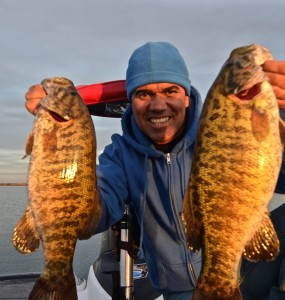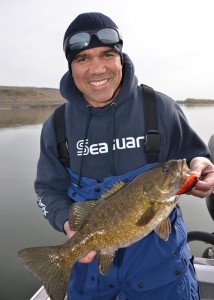Search
Latest Articles
Take Advantage of the Smallmouth Spawn
by Terry Otto for Anglers Club Magazine, May 02, 2017
Springtime smallmouth bass are here one day and gone the next as they migrate from their winter haunts to their spawning areas. Understanding the stages of the smallmouth spawn, and how the fish behave in each of those stages, is key if you want to catch them all season long.
The three stages are the pre-spawn, the spawn itself, and the post-spawn.
Smallmouth begin to get active when the water temperature tops 50 °, and they will begin to move shallower. “That’s when smallmouth will move out of winter spots and into pre-spawn areas,” says David Swendseid, a tournament angler and lure developer for Duo International. “They move up to secondary areas in depth and contour,” he says. “They look for coves and other protected areas near to deeper water.”
Pre-Spawn Patterns
The pre-spawn may be the best time of year to catch trophy smallmouth. The big, mature bass are hungry and aggressive as they beef up prior to the rigors of the spawn. They will feed actively until the smallmouth spawn begins. Swendseid says rattling crankbaits are hard to beat in this stage. “Pre-spawn bass are absolutely hungry,” he says. “But they need to see the profile, so crankbaits with a big body are effective.”
He prefers to throw the Duo Realis M-65 and M-6511, big baits with a pronounced rattle. “Early in the year they really whack it,” he says.
The Smallmouth Spawn
The spawn starts in earnest when the water temp hits about 60°. They look for spawning flats 4 to 8 feet deep with plenty of vegetation. Swendseid says at this point the fish are keying in to more than water temps, they are also driven by photoperiods. The increases in daylight hours will keep the smallmouth spawn going, even if the temps dip and stay lower.
“Bass are highly protective of their nests during the smallmouth spawn,” says Swendseid. They will attack anything that they think threatens the eggs, and that makes them vulnerable. If you can spot the beds, back away. Then toss soft plastics directly onto the bed. The bass will pick the bait up and move it off the nest.
Suspended jerk baits are also very good at this point, because they look like a fish that is after the eggs. “The bait that works best when bass are on the beds is the one that offends them the most,” says Swendseid.
In the early stages of the smallmouth spawn the female will help guard the nest. After a while they leave the males alone. Swendseid says the males “try to kill themselves,” running off intruders, battling other fish, and not feeding. In fact, when Swendseid sees a tattered-looking male guarding a nest, he leaves it alone. You should, too.
Always release spawning smallmouth near the beds they were guarding.
Post-spawn Smallmouth
After the eggs hatch the male will stay with the young fish for a short time, and then move off to recuperate. At this point the bass are looking for two things: “Depth and density,” says Swendseid. “They are looking for thick vegetation near deep water. They are not eating much, just hiding and resting.” As they recover a crankbait yanked through heavy vegetation will often draw strikes.
Eventually smallmouth will begin to move toward deeper water and into their summer patterns, all the while feeding more often. Usually by July the bass have completely recovered, and will spend the summer fattening back up for the coming fall and winter.
Reprinted By permission of Anglers Club Magazine.


